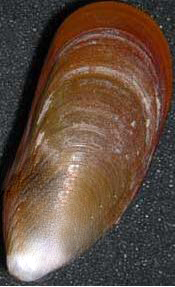|
Species
Mussels inhabit a wide range of estuarine and marine environments. They are sessile
and attach to rocks, jetties and piers, or sometimes form dense beds on sandy flat
substrates. Mussels can be found from the low tide level to a depth of 10 metres.
Mussels, like most bivalves (two shelled molluscs), are filter feeders and do not
require additional feeding. They strain phytoplankton (microscopic plant-like organisms)
from the water. They prefer plankton in the size range of 4 to 120
m (microns), with the majority of food being less than 20
m.
Of the two species of commercially important mussels, the green mussel Perna viridis
is widely distributed and found in small beds in Chilka Lake, Visakhapatnam,
Kakinada, Madras, Pondicherry, Cuddalore and Porto Novo on the east coast and extensively
around Quilon, Alleppey, Cochin, Calicut to Kasargod, Mangalore, Karwar, Goa, Bhatia
creek, Malwan, Ratnagiri and the Gulf of Kutch on the west coast. P. viridis
occurs from the intertidal zone to a depth of 15 m. On the other hand, P. indica
has restricted distribution and is found along the southwest coast from Varkala
near Quilon to Kanyakumari and from there to Tiruchendur along the southeast coast.
It occurs from the intertidal region to a depth of 10m.
Distinctive characters
The distinctive characters of the two species of Perna are given below:
|
Character
|
Perna viridis
|
Perna indica
|
|
External colour
|
Green
|
Dark brown
|
|
Mantle margin colour
|
Yellowish-green
|
Brown
|
|
Ventral shell margin
|
Highly concave
|
Almost straight
|
|
Middle dorsal margin
|
Arcuate
|
A distinct dorsal angle or lump present
|
|
Anterior end of shell
|
Pointed, beak-down turned
|
Pointed and straight
|
|
Number and size of hinge teeth
|
Two small teeth on the left valve and one on the right valve
|
One large tooth on the left valve and a corresponding depression on the right valve
|
|

Green mussel
|

Brown mussel
|
Exploitation
Kerala state can be called as the ‘Mussel fishery zone of India’ since
extensive beds of both the green and brown mussels occur in this state, which also
accounts for the bulk of the mussel production in the country.
Mussels are exploited during September-April. Good low tide, clear water and sunny
days are favourable for fishing. Women and children collect the mussels from the
intertidal areas. Mussels are collected by handpicking and a chisel or a knife is
used to dislodge the mussels from the rocks. Men either swim or use a canoe to reach
the fishing grounds and exploitation is restricted to 5 m depth. They may use masks
and carry a nylon bag tied to their waist to keep the catch. Both full time and
part time divers are engaged in the mussel fishery.
P. viridis : The major
mussel landing centres in the Cannanore-Calicut areas are Koduvally, Mahe, Chombala,
Moodadi & Thikkodi, Elathur, Challium and South Beach. The standing stock of
the mussels in this area has been estimated at 15,887 t in 555 ha of mussel beds
and the density varies from 2.25 to 4.5 kg/m2. The length of the mussels
varies from 20 mm to 129 mm with 50-90 mm group contributing to the bulk of the
catches.
P. indica : The important
fishing centres are Kovalam, Avaduthura, Vizhinjam, Mulloor, Pulinkudi, Chowara,
Colachel, Kadiyapatnam and Muttom. The standing stock is estimated to be 1,586 t.
Peak landings are during November-January. The population density of mussels is
about 5-8 kg/ m2.
Seed collection
Even though hatchery technology is available, mussel seed (10-35 mm spats) in adequate
quantities for culture operations is collected from the natural beds or by laying
collectors in the farm itself.
It has been reported that profuse settlement of spats of green mussel takes place
on granite embarkments and groynes laid along the central Kerala coast for prevention
of sea erosion. The density of seed varied from 220 to 248/100 cm2 on
the rocks submerged for most of the time and 112 to 170/100 cm2 in less
favourable surroundings. Favourable area for spat collection for brown mussel has
been the Vizhinjam area.
Top
|